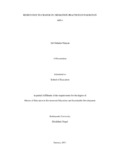
Please use this identifier to cite or link to this item:
https://hdl.handle.net/20.500.14301/234| Title: | RESISTANCE TO CHANGE IN CREMATION PRACTICES IN PASHUPATI AREA |
| Authors: | Singtan, Dal Bahadur |
| Citation: | Singtan,D.B.(2014)Resistance to change in cremation practices in Pashupati area. |
| Issue Date: | Jan-2014 |
| School: | SOED |
| Department: | DODE |
| Level: | Masters |
| Program: | KUMSD |
| Abstract: | This study has explored one of the main rituals of Hindus, which is death ritual. Since death ritual plays a vital role and bestows deep meaning on the Hindu system, I was interested in inquiring the views of my research participants about the death rites in today’s dynamic society. Cremation of the dead bodies is a custom followed since ancient time by Hindus. Furthermore, this study has dealt with two major issues of cremation; one is people’s perception about ongoing open-air cremation and another is their opinions on why electric crematorium which was supposed to be functional few years back is still not being completely installed. Kurt Lewin’s theory of change has guided this research as I found good grounds to compare the three stages of unfreeze-change-refreeze with the current scenario of possible cultural change in cremation practices; from conventional open air to indoor electric cremation. I chose narrative inquiry, a qualitative research method, in order to explore the religious and cultural subjectivity. Observation and detailed interviews were done to collect data. During the interviews entire ethical iii aspects such as informed consent and anonymity of participants were considered. Data were transcribed, and presented with necessary discussion and interpretation. The key findings are the changing perceptions of people; some of them tend to favor electric crematorium as it kept environment cleaner than current cremation way which kept pressure in forests, whereas those who are working for ongoing cremation felt insecure of their jobs and wanted alternative provision to be provided by Pasupati Area Development Trust in case of unemployment that may be caused by the installation of electric crematorium. Finally there were mixed responses regarding the possibility of shift in cremation from the ongoing open air to upcoming electric cremation. Resistive behavior of people due to cultural and religious attachment was found as the major problem for change. Whereas the need of time and consciousness of people regarding environmental pollution and degradation of aesthetic value of Pasupati area were found to be the driving forces for unfreezing of the system of ongoing cremation, stepping into the change stage and adopting the electric cremation as the refreezing step as suggested by the change theory of Lewin. |
| URI: | https://hdl.handle.net/20.500.14301/234 |
| Appears in Collections: | Research Project |
Files in This Item:
| File | Description | Size | Format | |
|---|---|---|---|---|
| Cremation_Edited_Final.pdf | 1.91 MB | Adobe PDF |  View/Open |
Items in DSpace are protected by copyright, with all rights reserved, unless otherwise indicated.